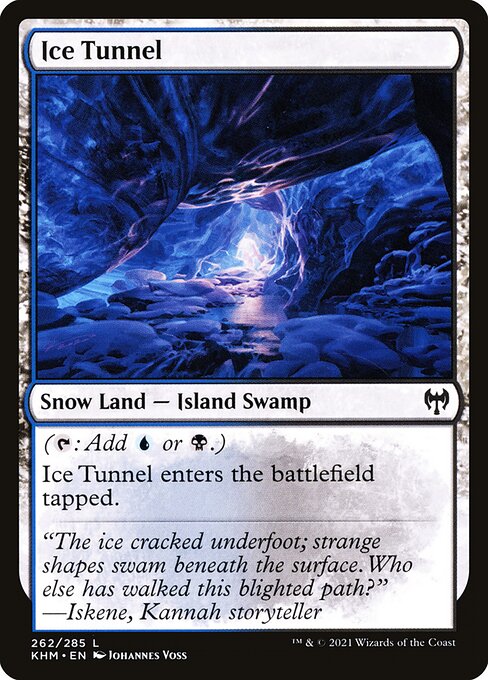
Image courtesy of Scryfall.com
Seeing through the Ice: Framing and Perspective in Ice Tunnel
Magic: The Gathering’s card art is a conversation between what you can play and what you can imagine. When a snow land like Ice Tunnel graces the battlefield, the frame isn’t just a decorative shell—it’s a storytelling lens 🧙♂️. Johannes Voss’s illustration leans into a precise, almost cinematic framing that invites viewers to descend into a frozen corridor. The tunnel’s mouth serves as a gateway, pulling your eye along ice-sharp ridges toward a distant, uncertain depth. That sense of depth isn’t accidental; it’s a deliberate use of perspective to mirror the card’s dual nature: a land that can produce either blue or black mana, yet enters the battlefield tapped as a cost for that flexibility. The composition grants a near-physical sense of “below” and “beyond,” turning a simple mana fixer into a miniature journey through a frozen, unknown world 🔮.
The piece leans into several classic framing devices that MTG artists use to great effect. First, the vanishing point—where lines in the tunnel converge—sits almost dead-center, guiding the viewer’s gaze to the heart of the image. The ice crystals along the cave walls arc outward, like the ribs of a frozen cathedral, creating a rhythm that moves your eyes deeper into the scene. Second, the use of scale is astute. Foreground ice spires loom large, while the tunnel narrows and recedes, giving the viewer a tangible sense of distance. Third, the color temperature is a study in contrast: icy blues against coal-dark shadows, with occasional glints of brighter white that suggest light filtering from above or from deeper fissures. All these choices work together to imply a passage not just through space, but through a moment in time—a path you could take, if you’re willing to pay the tap cost later on 🧊💙.
- Vanishing point near the center for a strong sense of depth
- Leading lines created by ice fissures and tunnel edges
- Foreground textures that exaggerate scale and tactile feel
- Cool color palette that hints at the dual identity of the land
In a broader sense, Ice Tunnel embodies the duality that Kaldheim’s snow frame often whispers: a world where surface elegance masks hidden complexity. The artwork communicates a cinematic mood—like a frame from a fantasy epic—while the card’s textual reality delivers a practical, game-ready tool: a land that taps for either blue or black mana, always with a tempo-tethered cost. This juxtaposition between beauty and function is what makes MTG art so enduringly resonant. The piece doesn’t merely illustrate a tunnel; it invites you to think about what lies beneath a surface that looks serene at first glance 🧙♂️⚔️.
Flavor, Frame, and Lore: Ice Tunnel in Context
The ice cracked underfoot; strange shapes swam beneath the surface. Who else has walked this blighted path?"
That flavor text breathes life into the image, turning the tunnel from a static backdrop into a narrative stage. Iskene, Kannah’s storyteller, hints at danger and mystery—perfectly matching the card’s practical identity as a Snow Land—Island Swamp. The line also nods to the broader mythic vibe of Kaldheim, where icy landscapes conceal histories and threats just out of sight. The art and the lore work in tandem to remind players that even “simple” mana sources can carry a tale as rich as any creature or spell. The snow frame emphasizes this, offering a frosted lens through which every minor decision—like which color to prioritize over the other—becomes a tiny, thematic choice 🎨🧊.
From a collector’s perspective, Ice Tunnel’s rarity (common) and existences in both nonfoil and foil editions reflect a balancing act: accessibility for players who want reliable dual-color mana while still offering foil gloss for those who chase visual pop. The 2015 frame, with its snow treatment, gives the artwork a seasonal cadence that pairs nicely with the wintery imagery you’ll find in many Kaldheim decks. Even the presence of the “Island Swamp” type line helps players remember that this land is not merely a splash of color but a deliberate strategic piece—one that can swing a game when your curve leans into both blue and black spells and tricks 💎🧭.
From Frame to Gameplay: Why Framing Matters in Deck-building
Framing isn’t a mere aesthetic exercise; it nudges players toward particular lineages of play. Ice Tunnel’s tapped entry creates a natural tempo check: you can deploy it to stabilize a turn or two, then unleash your blue or black spells once you’ve stabilized the board. The dual-mana capability invites your deck to flirt with both colors, even if your primary plan relies on one more than the other. In environments where snow synergies are less central than in other Kaldheim-focused builds, this card remains a flexible cornerstone for hybrid control/disruption archetypes. The art’s emphasis on depth and layered surfaces mirrors the layered decision-making in gameplay: when to crack the ice, when to march through the tunnel, and when to wait for the right window to push a win condition 🧙♂️🔥⚔️.
Artistically, Ice Tunnel aligns with MTG’s ongoing exploration of space and perspective. The tunnel’s geometry feels almost architectural, suggesting that the world of Kaldheim is not just about magic on a tabletop but about places you could almost walk through—if you were brave enough to step onto the ice and listen for the crack in the still air. The combination of a strong focal point, calculated depth, and a restrained color palette makes Ice Tunnel a memorable example of how framing supports both story and strategy 🎲.
Non-slip Gaming Mouse Pad Anti-Fray Edges 9.5x8inMore from our network
- https://crypto-acolytes.xyz/blog/post/ai-and-blockchain-for-transparent-supply-chains/
- https://crypto-acolytes.xyz/blog/post/ranking-the-best-gaming-soundtracks-of-all-time/
- https://blog.digital-vault.xyz/blog/post/granite-gargoyle-across-mtg-sets-power-scaling-deep-dive/
- https://blog.zero-static.xyz/blog/post/does-mirage-phalanxs-rarity-predict-its-mana-cost/
- https://blog.digital-vault.xyz/blog/post/chimeric-idol-mastering-power-toughness-ratios-in-mtg/